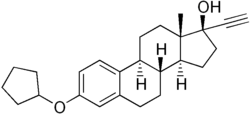Quinestrol
 | |
| Clinical data | |
|---|---|
| AHFS/Drugs.com | Micromedex Detailed Consumer Information |
| ATC code |
|
| Identifiers | |
| |
| Synonyms |
W-3566; 3-Cyclopentyloxy-17-ethynyl-13-methyl-7,8,9,11,12,14,15,16-octahydro-6H-cyclopenta[a]phenanthren-17-ol |
| CAS Number | |
| PubChem CID | |
| IUPHAR/BPS | |
| DrugBank | |
| ChemSpider | |
| UNII | |
| KEGG | |
| ChEBI | |
| ChEMBL | |
| ECHA InfoCard | 100.005.277 |
| Chemical and physical data | |
| Formula | C25H32O2 |
| Molar mass | 364.52 g/mol |
| 3D model (JSmol) | |
| |
| |
| | |
Quinestrol (INN, USAN, BAN) (brand names Agalacto-Quilea, Basaquines, Eston, Estrovis, Estrovister, Plestrovis, Qui-Lea), also known as ethinylestradiol 3-cyclopentyl ether (EE2CPE), is a synthetic, steroidal estrogen used in hormone replacement therapy and occasionally to treat breast cancer and prostate cancer.[1][2][3][4] It is a prodrug of ethinylestradiol (with cyclopentanol also being formed) with no intrinsic estrogenic activity of its own, and has a very long terminal half-life of more than 120 hours due to enhanced lipophilicity.[5] Because of its much longer terminal half-life, quinestrol is two to three times as potent as ethinylestradiol.[6] The drug was marketed as Estrovis in the United States by Parke Davis and as Qui-Lea in Argentina,[4] but is reportedly not currently marketed.[6] However, it does appear to be available as an oral contraceptive in combination with progestins in Argentina and China.[7] Quinestrol was described in the literature in 1967.[1]
See also
- Ethinylestradiol sulfonate
- Estradiol cypionate
- Mestranol
- Moxestrol
- Nilestriol
- Quinestradol
- Quingestanol
- Quingestanol acetate
References
- 1 2 J. Elks (14 November 2014). The Dictionary of Drugs: Chemical Data: Chemical Data, Structures and Bibliographies. Springer. pp. 522–. ISBN 978-1-4757-2085-3.
- ↑ I.K. Morton; Judith M. Hall (6 December 2012). Concise Dictionary of Pharmacological Agents: Properties and Synonyms. Springer Science & Business Media. pp. 243–. ISBN 978-94-011-4439-1.
- ↑ Christoph Zink (1 January 1988). Dictionary of Obstetrics and Gynecology. Walter de Gruyter. pp. 204–. ISBN 978-3-11-085727-6.
- 1 2 Index Nominum 2000: International Drug Directory. Taylor & Francis. January 2000. pp. 905–. ISBN 978-3-88763-075-1.
- ↑ Michael Oettel; Ekkehard Schillinger (6 December 2012). Estrogens and Antiestrogens II: Pharmacology and Clinical Application of Estrogens and Antiestrogen. Springer Science & Business Media. pp. 248–. ISBN 978-3-642-60107-1.
- 1 2 A. Wayne Meikle (1 June 1999). Hormone Replacement Therapy. Springer Science & Business Media. pp. 381–. ISBN 978-1-59259-700-0.
- ↑ https://www.drugs.com/international/quinestrol.html